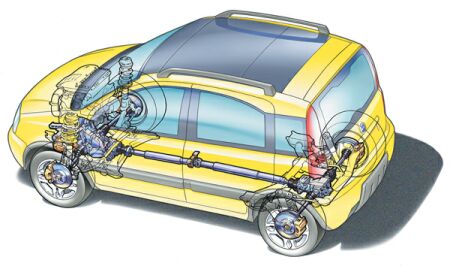 The engine is dynamic and economical. The fuel consumption during leisurely driving outside the city was 4,8 l/100km. At higher speeds, Panda consumed 5,7 l/100km, while on the highway – 6,4 l/100km. In the city, she burned approx 7,21/100 km. The average test result is 6,2 l/100km. Savings are favored by at least two features of the driveline: maximum torque achieved at a low engine speed (2500 for a minute) and long gear ratios, especially fifth gear (by 120 km / h only 3400 RPM). The pluses include good soundproofing of the engine and suspension (see loudness measurement).
The engine is dynamic and economical. The fuel consumption during leisurely driving outside the city was 4,8 l/100km. At higher speeds, Panda consumed 5,7 l/100km, while on the highway – 6,4 l/100km. In the city, she burned approx 7,21/100 km. The average test result is 6,2 l/100km. Savings are favored by at least two features of the driveline: maximum torque achieved at a low engine speed (2500 for a minute) and long gear ratios, especially fifth gear (by 120 km / h only 3400 RPM). The pluses include good soundproofing of the engine and suspension (see loudness measurement).
The result of the very long main ratio is unsatisfactory flexibility in the two highest gears. Therefore, before overtaking on the route, it is worth reducing the gear.
The suspension dampens bumps decisively, with a clear progression, which gives the driver a feeling of good control of the car. The power steering could work with less power, but it does not lack precision. The advantage of the car is good maneuverability (turning diameter - 9.1 m). To be parked backwards, parallel to the curb and without changing direction, enough space is enough 4,6 m.
Panda definitely doesn't like dynamic maneuvers – the car is tall and narrow so it tilts unpleasantly in the corners, which is keeping the driver from checking, where is the security line.
The trunk is functional more spacious than in the Seicento, and you can enlarge it. The backrest of the couch folds very easily.
The seat of the couch does not turn over and the backrest is folded down and the floor is not even. The backrest is divided proportionally 50:50, therefore the transport of longer items prevents a fourth passenger from traveling. Rear seats can be moved (expensive option) not much will change here. There are no strings to raise the shelf above the trunk when opening the tailgate.
Not all solutions in Panda are optimal, but this, most importantly: driving comfort, saving, instrument functionality, assembly quality – we consider it definitely positive.